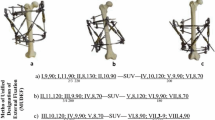Abstract
Detailed data of the stability of external fixation devices are needed by the orthopaedic surgeon to predict successful healing of a fracture. The stability (rigidity, yield and failure criteria) of four half-frame configurations (single, stacked, double and delta) of the original Hoffmann and AO tubular frame have been analysed under four loading conditions: axial compression, torsion, and both AP- and ML-bending. Overall the two systems' rigidities were the same between similar configurations. Both systems' single half-frames were particularly weak; however, as the number of components (rods, pins, clamps, couplings) on the frame increased, the rigidity of the frame increased. The difference in performance between the two systems lies in their yield and failure characteristics. The AO system exhibited excellent failure criteria in all modes of loading, i.e. no configuration failed within the test limits, whereas most Hoffman frames yielded and failed at low loads.
Similar content being viewed by others
References
Armstrong, R. D., Finlay, J. B. andRorabeck, C. H. (1985) Slippage in the Hoffmann universal joints. Proc. 9th Ann. Meeting of Am. Soc. Biomech., Ann Arbor, Michigan, 95–96.
Armstrong, R. D., Finlay, J. B. andRorabeck, C. H. (1986) Pin-bone interface stresses in external fixation: a reflective photo-elastic analysis. Proc. 32nd Ann. Meeting of the Orthopaedic Research Society, New Orleans, Louisiana,11, 338.
ASTM (1985) Standard test method for static bending properties of metallic bone plates. ASTM Designation: F382-81. In1985 Annual book of ASTM standards; Volume 13.01, medical devices.Priemonstorer, R. A. (Ed.), ASTM, Philadelphia, 90–93.
Berenson, M. L., Levine, D. M. andGoldstein, M. (1983) One-way ANOVA: completely randomized design, multiple comparisons and contrasts. InIntermediate statistical methods and applications.Gueterman, K. andPalumbo, B. (Eds), Prentice-Hall, Englewood Cliffs, New Jersey, 53–106.
Briggs, B. T. andChao, E. Y. S. (1982) The mechanical performance of the standard Hoffmann-Vidal external fixation apparatus.J. Bone & Joint Surg.,64-A, 566–575.
Chao, E. Y. S., Kasman, R. A. andAn, K. N. (1982) Rigidity and stress analyses of external fracture fixation devices—a theoretical approach.J. Biomech.,15, 971–983.
Egkher, E., Martinek, H. andWielke, B. (1980) How to increase the stability of external fixation units. Mechanical tests and theoretical studies.Arch. Orthop. Traumat. Surg.,966, 35–43.
Evans, M., Kenwright, J. andTanner, K. E. (1979) Analysis of single-sided external fracture fixation.Eng. in Med. 8, 133–137.
Finlay, J. B., Moroz, T. K., Rorabeck, C. H., Davey, J. R. andBourne, R. B. (1987) Stability of 10 configurations of Hoffmann external fixation frames.J. Bone & Joint Surg.,69-A, 734–744.
Goodship, A. E. andKenwright, J. (1985) The influence of induced micromovement upon healing of experimental tibial fractures. ——Ibid.,67-B, 650–655.
Green, S. A. (1981) InComplications of external skeletal fixation, Causes, prevention and treatment. C. C. Thomas, Springfield, Illinois, 1–174.
Karaharju, E. O. andAalto, K. (1983) The deformation of external fixation devices during loading.Int. Orthop. 7, 179–183.
Kempson, G. E. andCampbell, D. (1981) The comparative stiffness of external fixation frames.Injury. 12, 297–304.
Pope, M. H. andEvans, M. (1982) Design considerations in external fixation. InConcepts in external fixation.Seligson, D. andPope, M. H. (Eds), Grune & Stratton, New York, 109–135.
Scheffe, H. (1953) A method of judging all contrasts in the analysis of variance.Biometrika,40, 87–104.
Seligson, D. andStanwyck, T. S. (1982) The general technique of external fixation. InConcepts in external fixation.Seligson, D. andPope, M. H. (eds), Grune & Stratton, New York, 79–108.
Shiba, R., Chao, E. Y. S. andKasman, R. (1984) Fatigue properties of the Hoffmann-Vidal external fixation apparatus.Orthopaedics,7, 443–456.
Tencer, A. F., Claudi, B., Pearce, S., Bucholz, R. W. andJohnson, K. D. (1984) Development of a variable stiffness external fixation system for stabilization of segmental defects of the tibia.J. Orthop. Res. 1, 395–404.
Author information
Authors and Affiliations
Rights and permissions
About this article
Cite this article
Moroz, T.K., Finlay, J.B., Rorabeck, C.H. et al. Stability of the original Hoffmann and AO tubular external fixation devices. Med. Biol. Eng. Comput. 26, 271–276 (1988). https://doi.org/10.1007/BF02447080
Received:
Accepted:
Issue Date:
DOI: https://doi.org/10.1007/BF02447080




